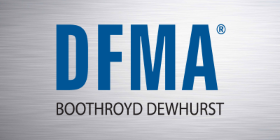C-Level Executives
C-Level Executives
What if the current fixation on reducing labor costs is only attacking 4% of the cost of goods sold? According to a Boothroyd Dewhurst, Inc. study, component costs make up 72% of the typical manufacturer’s cost of goods sold.
What if there was a tool that could help your design teams work on that 72%, by quickly examining realistic component cost alternatives?
What if they could start examining these alternatives—to meet competition-driven target cost—even before the detailed design phase?
And, once you had agreed on a design, what if you could get the best possible quotes from your vendors, because before you asked them for a quote on a particular part, you already knew what it cost, based on locale-specific averages?
The most efficient companies in the world are doing all of these things, using Design for Manufacturing and Assembly (DFMA) tools from Boothroyd Dewhurst, Inc. These practices are routine:
- Rather than just settle for the first concept that works, their design teams are able to play “what if” with cost, materials, and processes, until a component meets cost, quality, and assembly requirements.
- Design teams work directly and efficiently with manufacturing and costing teams, using a common analysis platform and communication method. Decisions are driven by real-world data rather than “we’ve always done it this way,” or “this is the data we got from suppliers.”
- Designers are able to reduce part count, which significantly reduces the cost of materials and labor. Harley-Davidson has used DFMA extensively for this purpose.
- Designers find new efficiencies in assembly and component standardization, which are then applied across product lines. Dell has been particularly adept at this.
- Drawings sent out for quotes include detailed cost analyses, helping suppliers understand that your team “knows the score” and gives your suppliers a reasonable basis of comparison as they build their estimates.
DFMA provides a powerful and efficient tool to help you get objective answers to your most common and pressing questions:
- What will it cost to manufacture this?
- Where could we cut costs—without sacrificing quality and/or competitive advantage?
- Have we examined all the alternatives?
- Are we sure this supplier’s price is the best we can do?
- Could we use other methods to manufacture this more quickly or less expensively?
- Have we looked at the related products and examined how we could consolidate processes or materials to cut costs?
- What is the competition doing, and how much do we think they’re spending on that part?
Competitive and cost advantages can be more easily achieved if your design, manufacturing, and cost management teams have a “what if” tool they can use to evaluate various alternatives, select the right one, and then use the results of their evaluation to successfully manage the design and manufacturing process.
DFMA from Boothroyd Dewhurst, Inc., is the “what if” tool that helps you lower costs of goods sold, while improving the quality and manufacturability of your products.
It’s obvious that you won’t be making this decision today, which means that more time will go by before you have a product making its way to the market. Meanwhile, your competitor has just launched a cheaper, yet superior product.
Whatever the question, it always takes too long to get answers. Calls have to be made to suppliers. Designers have to change their designs and then recalculate the cost of the component. Manufacturing has to estimate the cost of the part. Cost management has to gather input from all parties and recalculate. Meanwhile, it’s become obvious that one of your suppliers is overcharging you for a standard part. They have to be confronted and the contract has to be renegotiated.
All of these “real world” issues get in the way of getting straightforward answers to seemingly simple questions.
What if all “running the numbers” meant was that the engineer could simply plug some new variables into a DFMA model, and click a button to produce a detailed report, including graphic and tabular data? What if your engineer could run several of these reports prior to your meeting, in preparation for the questions you’re always asking?
You would get answers to your questions. You could spend time discussing the tradeoffs instead of always asking for more data. You could go to market faster and give that competitor a run for his money.
Real data. Better decisions. That’s the power of DFMA.




